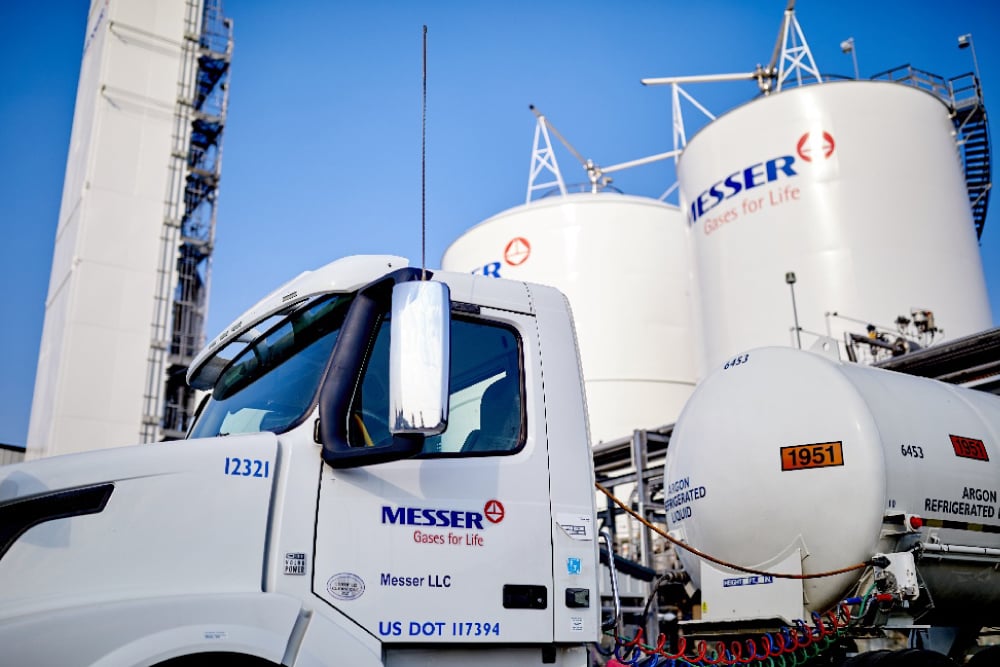Ask our team. We’re here to help.
Argon is a widely used, inert gas essential for industries ranging from metallurgy and welding to advanced manufacturing like 3D printing and hot isostatic pressing (HIP). As the least costly noble gas and heavier than air, it shields, blankets, and protects materials at high temperatures making it critical for certain chemical and high-temperature production applications.
Messer is ready to support you with:
Safety is a core value and embedded in everything we do at Messer. Hazards of liquid or gaseous argon include oxygen deficiency, asphyxiation, cryogenic burns, pressure build-up, and material embrittlement. Argon is heavier than air and can quickly displace oxygen in low-lying areas, posing a potential safety risk. One critical safeguard when working with argon is the use of oxygen monitors to detect an oxygen deficient atmosphere. Here are resources to learn more about argon safety:

Whether your goal is to reduce weld defects, reduce oxidation rates, or achieve precise manufacturing of 3D-printed parts, Messer provides:

As a leading argon gas supplier, Messer can meet the specific needs of your application, in various forms and purities:
Whether you’re looking for argon gas for welding, pure argon gas, or argon gas for windows, Messer has the right solution for you.

Do you need additional specifications? No problem. Simply contact us.

Do you need additional specifications? No problem. Simply contact us.
In aluminum and copper production, argon is used for degassing and stirring molten metal. The argon removes dissolved gases like nitrogen and hydrogen that can create impurities that could weaken the final product. It provides increased temperature control throughout the furnace and prevents unwanted oxidation during the refining and alloying stages.
In titanium production, argon is used in the Kroll Process, Vacuum Arc Remelting, refining and casting to prevent oxidation and any contamination.
Argon is also used in magnesium and other rare earth metals production during melting and casting to prevent oxidation and maintain an inert environment for these highly reactive and flammable metals.
In carbon and alloy steelmaking, argon is injected at bottom of an Electric Arc Furnace (EAFs) and Basic Oxygen Furnaces (BOFs) to help to improve alloy homogeneity, improve energy efficiency, and reduce the content of unwanted gases in molten steel. It’s used to stir the bath and prevent oxidation, which results in stronger, cleaner, and more consistent steel products.
High-carbon molten steel is transferred to the Argon Oxygen Decarburization (AOD) converter, where argon is used to refine the steel by removing carbon while preserving chromium and other valuable elements before further processing.
Argon creates a protective, oxygen-free atmosphere during heat treatment processes like annealing and sintering. This prevents surface oxidation, preserves material properties, and enhances the overall quality and consistency of treated parts, particularly in sensitive alloys and high-performance components.
It is especially important for alloys with high chromium or cobalt content, such as stainless steels, nickel-based alloys, and cobalt-chrome (CoCr) alloys. Chromium can react with nitrogen at high temperatures to form nitrides that can negatively impact corrosion resistance and mechanical properties.
Powdered metals like titanium and nickel are used to create parts for sintering, HIPing, 3D printing, and thermal spraying. Gas atomization is a process where the molten metal is injected through a high-velocity gas jet (usually using argon) that creates droplets that solidify into tiny, spherical metal particles. Argon is used to prevent oxidation in this high-temperature environment.
Argon is the preferred pressurizing medium in HIP vessel because it remains inert even at high temperatures and pressures. It applies uniform pressure in all directions, around complex metal or ceramic parts, and achieves superior strength and durability.

Argon provides the inert atmosphere essential for producing high-quality parts in 3D printing. It protects molten metal from oxidation during powder bed fusion, ensures consistent powder quality during production, and supports post-print heat treatment to preserve material properties and finish. Messer’s ASURE3D™ solutions optimize these processes with reliable, high-purity argon delivery.
While nitrogen is commonly used for inerting in most chemical industries, argon is the preferred choice in situations where nitrogen’s slight reactivity is unacceptable. In specialty chemical production, research environments, and high-purity processes, argon provides an ultra-inert, oxygen-free atmosphere to protect sensitive materials that can result in the highest product quality.
In electronics and semiconductor manufacturing, ultra high purity argon provides precise, contamination-free environments for processes like plasma etching, ion implantation, and annealing. Its inert nature and consistent quality help manufacturers achieve tight tolerances and high yields in complex microelectronics.
Argon is widely used for blanketing, purging, pressure transfer, and creating controlled environments in applications involving highly reactive or heat-sensitive chemicals and nuclear fuels. In industrial autoclaves, argon helps maintain an inert atmosphere essential for certain industry and manufacturing codes. Messer can support customers who require argon to meet these strict process and safety standards.
In welding, argon shields the molten weld pool from atmospheric gases, producing cleaner, stronger welds with fewer defects. Argon and argon mixtures are used in:
Argon is commonly used as a shielding gas in laser cutting processes. It provides an inert atmosphere that prevents oxidation and contamination of the metal being cut. The laser generates extremely high heat, melting or vaporizing the material with precision, while argon protects the cut edges and helps achieve clean, high-quality finishes. Argon’s properties make it suitable for cutting a wide range of metals, including stainless steel and aluminum, where maintaining metal integrity is critical.
Argon plays a key role in glass manufacturing and processing by providing an inert atmosphere that prevents oxidation and contamination during tempering, coating, and annealing.
Argon is also used in insulating glass products to improve energy efficiency and performance. By filling the space between panes in double- or triple-glass assemblies (e.g., windows, skylights, curtain walls, and façades), argon reduces heat transfer, enhances thermal insulation, and improves overall comfort, helping to lower energy costs in buildings and homes.